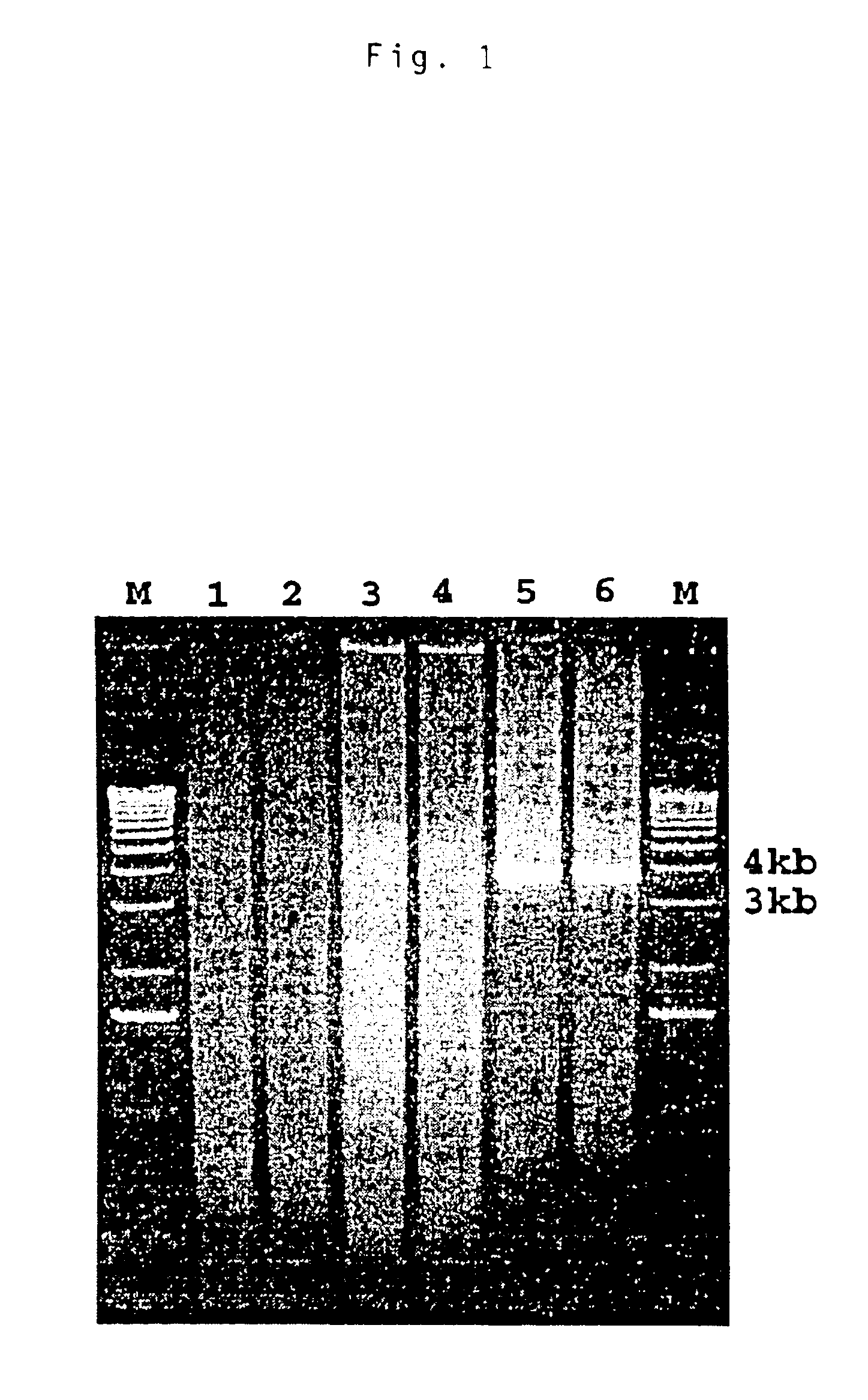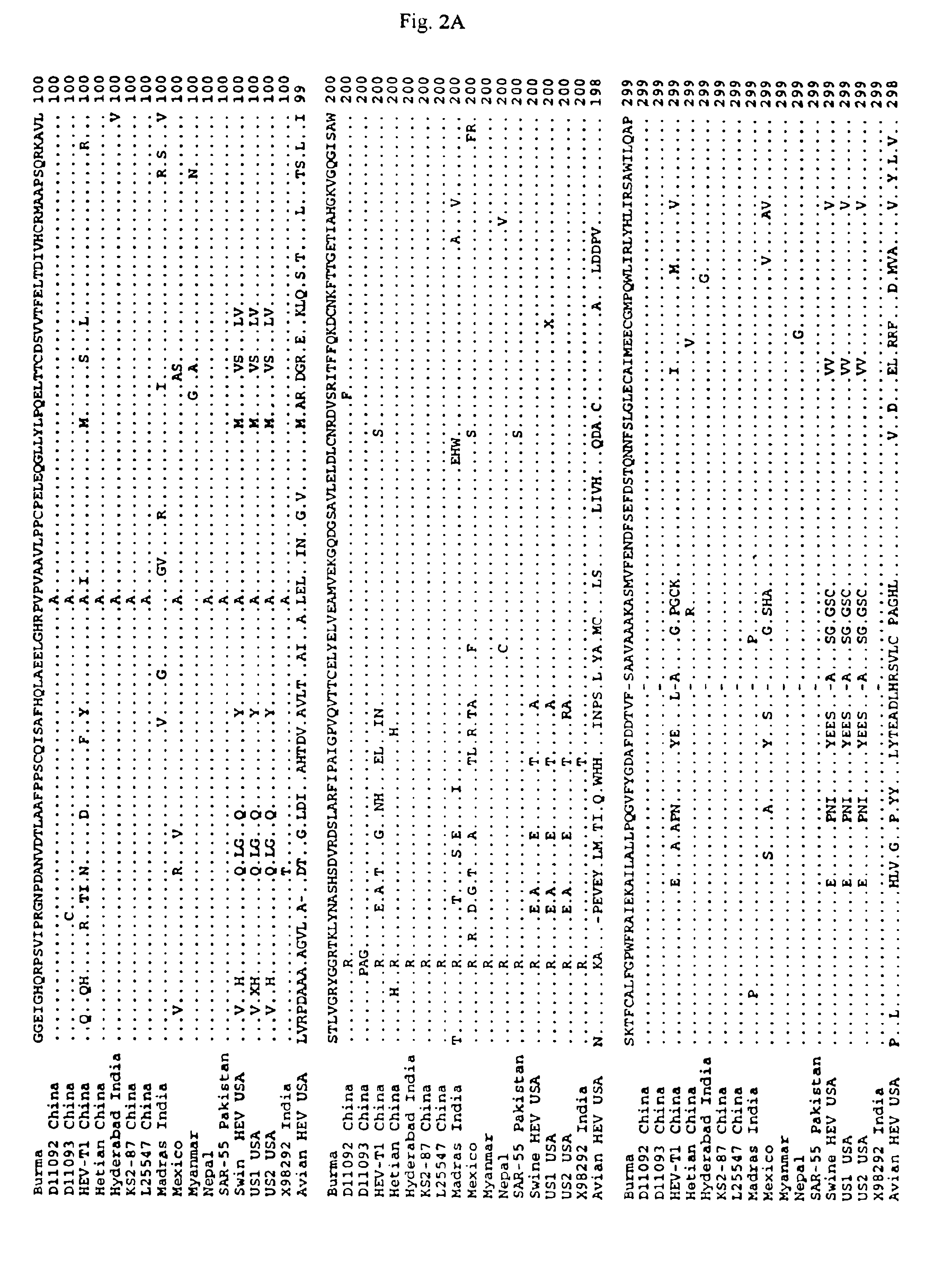Avian hepatitis E virus, vaccines and methods of protecting against avian hepatitis-splenomegaly syndrome and mammalian hepatitis E
a technology of avian hepatitis e virus and vaccine, applied in the field of new drugs, can solve the problems of not providing a good, adaptable animal model to study human hepatitis replication and pathogenesis, and the source of seropositivity in these animals cannot be definitively demonstrated
- Summary
- Abstract
- Description
- Claims
- Application Information
AI Technical Summary
Benefits of technology
Problems solved by technology
Method used
Image
Examples
example 1
Biological Amplification of the Virus in Embryonated Chicken Eggs
[0088]A sample of bile collected from a chicken with HS in California was used in this study. Electron microscopy (EM) examination showed that this bile sample was positive for virus particles of 30 to 40 nm in diameter. The limited bile materials containing the virus prevented the performance of extensive genetic identification and characterization of the virus. A preliminary study was conducted to determine if the virus could be biologically amplified in embryonated chicken eggs. SPF eggs were purchased at one day of age (Charles River SPAFAS, Inc., North Franklin, Conn.) and incubated for 9 days in a 37° C. egg incubator. At 9 days of embryonated age, 6 eggs were inoculated intravenously with 100 μl of a 10−3 dilution and 6 eggs with a 10−4 dilution in phosphate buffered saline (PBS) of the positive bile sample. Six eggs were uninoculated as controls. The inoculated eggs were incubated at 37° C. until 21 days of age...
example 2
Amplification of the 3′ Half of the Viral Genome
[0089]Based on the assumption that the putative virus associated with HS in chickens shared nucleotide sequence similarity with human and swine HEV, a modified 3′ RACE (Rapid Amplification of cDNA Ends) system was employed to amplify the 3′-half of the viral genome. Briefly, the sense primer, F4AHEV (Table 1 below), was chosen from a conserved region in ORF1 among known swine and human HEV strains including the big liver and spleen disease virus (BLSV) identified from chickens in Australia (C. J. Payne et al., “Sequence data suggests big liver and spleen disease virus (BLSV) is genetically related to hepatitis E virus,” Vet. Microbiol. 68:119-25 (1999)). The antisense primers included two anchored commercial primers of nonviral origin (GIBCO-BRL, Gaithersburg, Md.): AUAP (Abridged Universal Amplification Primer) and AP (Adapter Primer) with a poly (T) stretch (Table 1, below). Total RNA was extracted from 100 μl of the bile by TriZol r...
example 3
Cloning of the Amplified PCR Product
[0092]A PCR product of approximately 4 kb was amplified by the modified 3′ RACE system. The PCR product was excised and eluted from the agarose gel with the CoNcERT™ Rapid Gel Extraction System (GIBCO-BRL). The purified PCR product was subsequently cloned into a TA vector. The recombinant plasmid was used to transform competent cells supplied in the AdvanTAge™ PCR Cloning Kit (Clontech Laboratories, Inc., Palo Alto, Calif.) according to the manufacturer's instruction. White colonies were selected and grown in LB broth containing 100 μg / ml of ampicillin. The recombinant plasmids containing the insert were isolated with a Plasmid DNA Isolation kit (Qiagen Inc., Valencia, Calif.).
PUM
| Property | Measurement | Unit |
|---|---|---|
| time | aaaaa | aaaaa |
| time | aaaaa | aaaaa |
| temperature | aaaaa | aaaaa |
Abstract
Description
Claims
Application Information
 Login to View More
Login to View More - R&D
- Intellectual Property
- Life Sciences
- Materials
- Tech Scout
- Unparalleled Data Quality
- Higher Quality Content
- 60% Fewer Hallucinations
Browse by: Latest US Patents, China's latest patents, Technical Efficacy Thesaurus, Application Domain, Technology Topic, Popular Technical Reports.
© 2025 PatSnap. All rights reserved.Legal|Privacy policy|Modern Slavery Act Transparency Statement|Sitemap|About US| Contact US: help@patsnap.com



